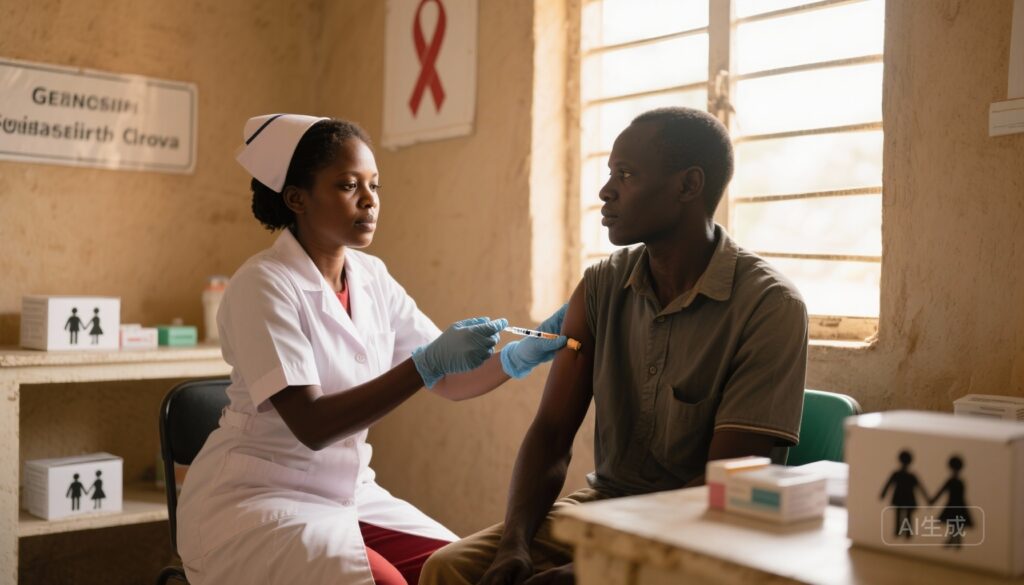Highlight
• In the randomized phase 3b CARES trial among 512 African adults with suppressed HIV-1 on first-line oral therapy, switching to cabotegravir (600 mg) plus rilpivirine (900 mg) long‑acting intramuscular injections every 8 weeks maintained viral suppression (HIV‑1 RNA <50 copies/ml) in 97% at 96 weeks and met prespecified noninferiority vs continued oral therapy (difference -0.4%; 95% CI -3.1% to 2.0%).
• Grade ≥3 adverse events were more frequent in the long‑acting group (16% vs 9%), but most were judged unrelated to study drugs; only one treatment‑related event (injection‑site abscess) led to discontinuation.
Background
Long‑acting injectable antiretroviral therapy (LA‑ART) offers a paradigm shift in chronic HIV management by reducing pill burden and supporting adherence through infrequent clinic‑based injections. Cabotegravir (an integrase strand transfer inhibitor) combined with rilpivirine (a non‑nucleoside reverse transcriptase inhibitor) as a long‑acting intramuscular formulation (Cabenuva) has been evaluated in multiple randomized trials in high‑income settings and is licensed for maintenance therapy in people who are virologically suppressed on antiretroviral therapy.
However, the global burden of HIV remains concentrated in sub‑Saharan Africa, where health system constraints, high incidence of coinfections (especially tuberculosis), programmatic logistics, and social determinants influence the feasibility and impact of LA‑ART. Robust evidence from African populations has therefore been a pivotal gap for policy and implementation decisions.
Study design
The CARES trial (Kityo et al.; Nat Med 2025) is a multicenter, randomized, open‑label, phase 3b noninferiority study conducted in African adults with HIV‑1. Key eligibility criteria included adults on first‑line oral ART, plasma HIV‑1 RNA <50 copies/ml at screening, and no prior virologic failure. A total of 512 participants were randomized 1:1 to either continue their oral regimen or switch to cabotegravir 600 mg and rilpivirine 900 mg administered intramuscularly every 8 weeks. An optional 4‑week oral lead‑in was permitted. The primary efficacy endpoint for the analysis reported to 96 weeks was the proportion with plasma HIV‑1 RNA <50 copies/ml by the FDA snapshot algorithm in the intention‑to‑treat exposed population, with a prespecified noninferiority margin of 10%.
Viral load monitoring occurred every 24 weeks; safety, tolerability (including injection‑site reactions), and adverse events were recorded throughout follow‑up. The trial is registered at the Pan African Clinical Trials Registry (PACTR 202104874490818).
Key findings
Primary efficacy at 96 weeks
At week 96, viral suppression (HIV‑1 RNA <50 copies/ml) was observed in 247 of 255 participants (97%) randomized to long‑acting (LA) cabotegravir + rilpivirine, compared with 250 of 257 participants (97%) remaining on oral therapy. The between‑group difference was -0.4% (95% confidence interval -3.1% to 2.0%), comfortably within the preassigned 10% noninferiority margin, demonstrating sustained noninferiority of the LA regimen over nearly two years of follow‑up.
Interpretation and clinical relevance
The high proportions of maintained suppression in both arms indicate excellent durability of viral control in a real‑world relevant African trial population that started with baseline suppression and no prior virologic failure. The narrow confidence interval around the difference supports robust statistical noninferiority and clinical equivalence for maintenance of suppression through 96 weeks when switching to LA‑ART.
Secondary and operational outcomes
The published summary focuses on virologic and safety endpoints. Additional operational considerations—such as visit adherence, missed injection windows, patient‑reported outcomes, quality‑of‑life measures, and resistance analyses—are essential for implementation but were not detailed in the brief summary; readers should consult the full manuscript and supplemental material for those data.
Safety and tolerability
Adverse events (AEs) of grade ≥3 occurred in 41 of 255 participants (16%) in the LA group compared with 22 of 257 (9%) in the oral group. The majority of these events were judged unrelated to study drugs by investigators. Injection‑site reactions (ISRs) are an anticipated class effect for LA injectable regimens; in CARES the only documented treatment‑related AE that led to discontinuation was an injection‑site abscess.
Clinical implications of safety findings
While the higher frequency of grade ≥3 AEs in the LA arm warrants attention, the predominance of events deemed unrelated to study drugs is reassuring. Injection‑site infections are uncommon but clinically important given their potential to interrupt therapy. Overall, the safety profile described is consistent with earlier pivotal trials conducted outside Africa and supports an acceptable tolerability profile for programmatic rollout with appropriate monitoring and systems to manage ISRs and other AEs.
Expert commentary and contextualization
How CARES adds to existing evidence
Prior randomized studies of cabotegravir + rilpivirine long‑acting (pivotal trials and extension studies) demonstrated noninferiority to oral maintenance ART in predominantly non‑African populations and informed regulatory approvals in several jurisdictions. CARES fills a critical evidence gap by confirming durable efficacy and an acceptable safety profile specifically in African adults, supporting greater geographic generalizability and informing national treatment programmes.
Practical considerations for African HIV programs
- Clinic delivery and workforce: LA‑ART requires trained staff to administer gluteal or deep intramuscular injections, appointment systems to deliver injections on schedule (every 8 weeks), and protocols to manage missed injections. Programs will need to weigh resource allocation between clinic‑based delivery and decentralization strategies.
- Cold chain and storage: Cabotegravir–rilpivirine LA formulations have specific storage requirements that local supply chains must accommodate; procurement planning is essential.
- Coadministration with TB treatment: Rifampicin and other potent inducers reduce cabotegravir exposure and are generally contraindicated with this regimen; high TB burden in parts of Africa necessitates clear pathways for persons starting or needing TB therapy to switch regimens safely.
- Eligibility and equity: CARES enrolled patients who were virologically suppressed and without prior virologic failure; implementation should consider how to expand access equitably while preserving safety and minimizing risk of resistance emergence in populations with prior failure or nonadherence.
- Cost and supply: Procurement costs, financing, and sustainable supply chains will determine scalability; cost‑effectiveness analyses contextualized to local ART costs, clinic capacity, and patient preferences are needed.
Limitations and areas for further research
Key limitations include the trial’s enrollment criteria (participants were stable on first‑line therapy with no prior virologic failure), which limits direct generalizability to people with prior resistance, adherence challenges, or those requiring concomitant rifampicin‑based TB therapy. The brief report does not present granular data on emergent resistance, adherence metrics for injection visits, pregnancy outcomes, or long‑term (>96 weeks) retention and outcomes; these data are essential for policy decisions.
Future work should address implementation research questions—clinic workflows, task‑shifting models (e.g., community injection delivery), cost‑effectiveness in programmatic settings, safety in pregnancy and breastfeeding, interaction with TB treatment, and outcomes in populations with prior ART failure or baseline resistance.
Conclusion
The CARES phase 3b randomized trial demonstrates that switching virologically suppressed African adults from oral first‑line ART to cabotegravir plus rilpivirine long‑acting injections every 8 weeks maintains viral suppression through 96 weeks and shows an acceptable safety profile. These findings support inclusion of LA‑ART as an additional option in African HIV treatment programs for appropriately selected patients, provided that systems are in place to manage injections, monitor safety, and respond to coinfection challenges such as tuberculosis.
Policy makers and programme implementers should consider CARES as strong region‑specific evidence that long‑acting injectable maintenance therapy can be effective and acceptable in Africa, while planning for addressing logistical, clinical, and equity challenges during rollout.
Funding and trial registration
Funding and detailed sponsor information are reported in the original publication (Kityo et al., Nat Med 2025). Trial registration: Pan African Clinical Trials Registry PACTR 202104874490818.
Selected references
1. Kityo C, Mambule IK, Musaazi J, et al.; CARES trial team. Cabotegravir and rilpivirine for treatment of HIV infection in Africa: week 96 results from the phase 3b randomized, open‑label, noninferiority CARES trial. Nat Med. 2025 Nov 4. doi: 10.1038/s41591-025-04041-7. PMID: 41188524.
2. World Health Organization. Consolidated guidelines on HIV prevention, testing, treatment, service delivery and monitoring: recommendations for a public health approach. WHO. (Consult most recent WHO consolidated guidance for national policy development and programmatic considerations.)
3. U.S. Food and Drug Administration. Cabenuva (cabotegravir and rilpivirine) injection — prescribing information and approval history. (Regulatory details and product information relevant to clinical use and safety monitoring.)
AI image prompt for article thumbnail
A clinic scene in sub‑Saharan Africa: a trained nurse in scrubs giving a gluteal intramuscular injection to an adult patient seated in a private consultation area; the patient looks reassured. Background shows a modest clinic room with shelves containing labeled medication boxes and educational posters about HIV care. Warm natural light, realistic photographic style, professional and hopeful mood.



